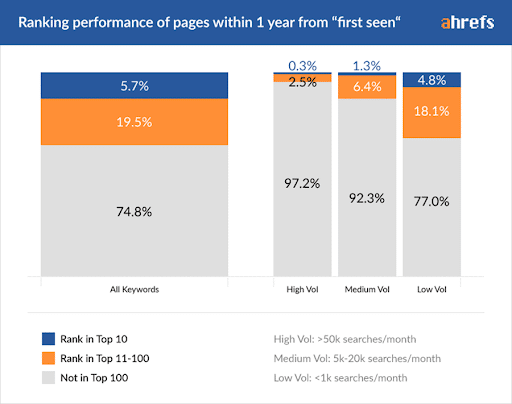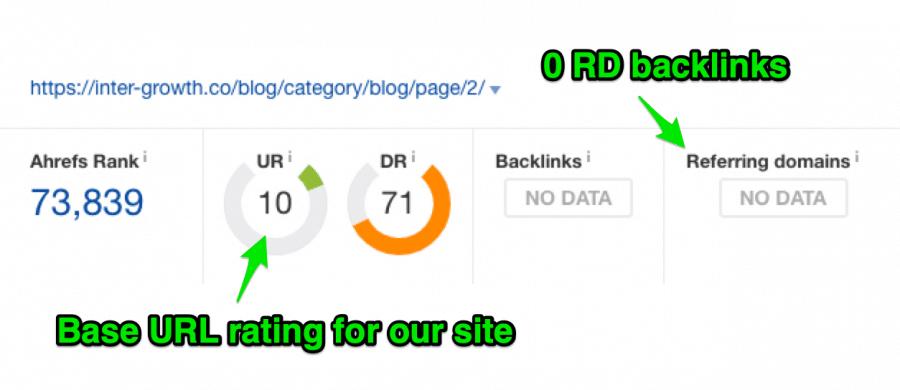In the past few years, I’ve seen an emerging keyword research process that simplifies keyword research. However, this approach kills results.
This approach is what I like to call the “Minimum Search Volume Threshold Approach.”
The core of this approach is the desire to target search terms with a minimum threshold of 1,000 organic searches/month.
The mindset that we often hear is that search volumes lower than this threshold won’t generate any meaningful search traffic and aren’t worth pursuing.
We disagree.
The Minimum Search Volume Threshold
The Minimum Search Volume threshold approach boils keyword research down to four steps:
- Brainstorm seed keywords to write about. Build a list of keywords related to those seed keywords
- Plug dozens of keyword ideas into a keyword research tool like SEMRush or Google Keyword Planner
- Eliminate keywords that don’t meet their monthly search volume criteria, keyword difficulty scores, CPC estimates, and other metrics
- Write an informational article or create a landing page about the best keywords that they find.
Our topic analysis process follows a similar approach. However, we have issues with the minimum search volume component.
Businesses that take this approach face an uphill battle as they struggle to drive results through SEO.
Why This Minimum Search Volume Approach Fails
Aggressive minimum search volume frameworks strip the necessary complexity out of keyword research.
SEOs need to consider short vs. long-term ranking potential, transactional intent, business growth goals, and whether their team has the resources to create the type of content needed to rank for a given search query.
However, there are two main reasons that this framework often fails.
1. This Approach Ignores the Short-Term Growth Potential of SEO
Marketers regularly talk about how content marketing and SEO work in the long term. Marketers rarely discuss how SEO works in the short term.
Long term, businesses that invest in content marketing grow exponentially. Each new keyword ranking drives more traffic, brand awareness, and backlink potential. All of these elements come together to help build a second keyword ranking over time, which helps to build a third keyword ranking, and so on until the page ranks for dozens of different keywords.
But what’s the catalyst that brings that first ranking?
Competition is often fiercer for high-volume keywords than low-volume keywords. Most businesses targeting a high-volume query will need to build more site authority to rank for that query.
In other words, another factor needs to come into play for the business to start ranking for that keyword.
Content marketing can help them to grow from 5,000 -> 10,000 visitors/month with the Minimum Search Volume Framework. However, content marketing isn’t helping them to grow from 0 -> 5,000 visitors with this approach.
Most businesses build that site authority through other techniques (word of mouth, PPC ads, social media, etc.). With this approach, content marketing isn’t the catalyst that drives initial business growth.
2. This Approach Ignores Google’s Buffer Time
Ahrefs put together a full study on the average time that it takes for a new page to rank in the top 10 positions of Google.
Their finding? Only 5.7% of studied pages ranked in the top 10 results within a year of being seen by Ahrefs for at least one keyword.
As you can see from the chart above, the percentage of pages ranking in the top 10 within a year of being discovered is 15x higher for keywords with <1k searches/month than keywords with >50k searches/month.
Barring clients that have higher domain authority scores, we see the same trend time and time again when targeting keywords with a higher search volume (1k+ searches/month):
- The article goes live. No rankings.
- We spend 3-6 months building links to the article until our URL rating beats two of the existing top 10 results for our target keyword. No rankings.
- We give the article time to gain traction. Over the next six months, the article starts to rank in the top 20 for other relevant keywords. The article also bounces from <20 to >100 on a daily basis for our primary keyword.
- Over the next six months, the article starts to rank in the top 10 for related searches with a smaller monthly search volume. The article still bounces from <20 to >100 on a daily basis for our primary keyword.
- Over the next 3-6 months, the article starts to rank in the top 10 for our primary keyword.
I believe that Google doesn’t want to risk ruining user experience for a high-volume query. Instead of testing a new result, the search engine trusts its original choices of the top 10-20 search results and largely limits ranking changes to micro-changes between those top 20 results.
Google needs to see sufficient outside evidence that the new page (and domain at large) deserves to be tested in the top search results to see if it does belong in one of the top results in the long term. As a result, I believe Google incorporates a buffer time on most new pages to collect data before allowing a new page to rank for a high-volume query.
I also believe Google watches the page over time and looks for opportunities to run micro-tests to see how the page performs for lower-value searches that share the same user intent (long-tail keyword variants, and eventually search results 11-20 for the head keyword).
Right or wrong, the data shows that ranking for a high-volume keyword requires patience.
So why not try a faster approach?
Here’s What We Do Instead
Rather than target high-volume keywords, we target queries that we deserve to rank for today.
How?
We focus on Google’s three most important ranking factors: content, RankBrain, and links.
- Content: we write the best resource on the internet about each subject that we cover.
- RankBrain: we ensure that the content we write matches search intent. In other words, it’s the right type of content to rank for a given search theme (and has everything that a searcher is hoping to find)
- Links: we ensure that a new page on our site will be authoritative enough to rank for the search theme today. If not, we design a link building plan to get that page to rank over time.
Our Head of Content, Jinny McCormick, wrote an in-depth breakdown that speaks to the content and RankBrain components of our SEO strategy. Here, I want to talk about links.
How Do We Define Whether a New Page is Authoritative Enough to Rank?
For us, authority analysis starts with identifying our baseline URL rating.
We find a page on our site with minimal inlinks and no external backlinks — a paginated category page is a great starting point.
For example:
/blog/category/blog/page/2/
From there, we log into Ahrefs and find that page’s URL Rating (Moz and SEMRush will work for the same purpose):
For example, one of the category pages on our site from before we rebranded shows a URL rating of 10.
We can assume that a brand new page that we publish on our site will have a baseline URL rating of 10.
If our team wants to rank for a given search theme, we can look at the existing pages that rank for that theme on Google and other search engines to see how our baseline URL rating stacks up.
Here are the guidelines we work with:
- If our baseline URL rating is higher than two or more of the current top 10 results, our newly published article should rank on the first page of search engine results pages (SERPs) in 1-3 months.
- If our baseline URL rating is lower than all of the current top 10 results, our newly published article will only rank in the top 10 results after we’ve built more authority to this page.
To clarify, I’m not saying to avoid high-volume keywords. Larger businesses will often have the luxury of targeting high-volume search themes because they have higher baseline URL ratings.
I am saying that you should weigh your baseline URL rating against the URL rating of the pages that rank for that high-volume keyword. This will help to paint a realistic picture of whether or not your page will have the authority to rank today.
If it’s not realistic to rank, why waste the resources to write an article that won’t see results?
How We Optimize for Short + Long-Term SEO
When writing about a new topic, we take the approach outlined above to identify the short-term ranking goals for our topic.
Our goal is to find one variant of the keyword theme that we’ll be able to rank for within 1-2 months.
Once we’ve found that variant, we optimize the article for that specific keyword. We use term frequency-inverse document frequency (TF-IDF) to identify related subtopics to discuss and optimize around as well (I highly recommend Clearscope for this analysis process).
In 1-2 months, we start seeing new traffic from that particular keyword, which helps us achieve the next semantically related keyword ranking for that article. The process snowballs until that content starts ranking for high-volume keywords.
For example, one client article that we published in June 2020 was optimized for a query that saw 90 searches/month.
The article saw 20 organic sessions in June and 30 in July. In August, organic traffic grew to 193 sessions for this page.
Seven months after being published, it’s now the 3rd-highest organic traffic driver on the site.
Going after high-volume keyword phrases is similar to pushing a boulder up a hill. You’re going to have to work your ass off to get to the top, and progress will be slow the whole way up.
Targeting a lower-competition variant creates the escalator effect. You start ranking for the first query almost immediately, which takes you up a level to rank for the next query.
This approach to keyword research is just one factor that enables our team to 2x, 3x, and 4x clients’ businesses every 12 months through our SEO consulting work and content marketing services.
Ready to grow your business? Let’s see if we’re the right team to partner with you.
SCALE YOUR ORGANIC TRAFFIC
Subscribe to our monthly newsletter







